Tutt* a casa!
Obiettivi per il capitolo
At the end of this chapter, students should be able to…
- talk about their daily routines
- describe their home environments
- refer to the positions and places of people, animals and/or objects
- describe the manner, time, and frequency of different actions
5.1 Introduzione al capitolo. Ascoltiamo!
Listen to the song and put the activities from the chorus (the ritornello in Italian) in the order they are mentioned. Note that three of them are used twice. What do these verbs have in common? What do you think the “ri” means (like in riasciugo and rituffo)?
|
mi asciugo mi riasciugo mi tuffo mi rituffo mi bagno mi ribagno mi rilasso mi giro mi rigiro |
___________________ ____________________ ____________________ ____________________ ____________________, ____________________ ____________________, ____________________ ____________________, ____________________ ____________________ ____________________ |
Esercizi
A. Vocabolario. Abbina le parole del ritornello alle immagini corrispondenti.
1.  |
a. mi rilasso |
2.  |
b. mi asciugo |
3.  |
c. mi giro |
4.  |
d. mi bagno |
5. 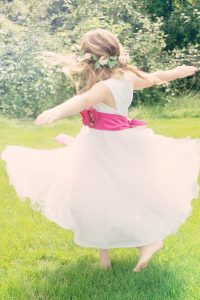 |
e. mi tuffo |
B. Comprensione. Parte I. Per Alex Britti, la vasca rappresenta “un’utopia”, dove ci sono solo cose belle (e dove può andare per evitare le cose brutte). Quali sono gli elementi di questa “utopia” secondo la canzone? Scegli le attività che lui menziona con un ✅.
| ballare in discoteca | |
| mangiare senza ingrassare | |
| viaggiare per il mondo | |
| non andare al lavoro | |
| comprare una bella casa | |
| passare tempo con gli amici al mare | |
| vincere la lotteria | |
| andare a scuola senza entrare |
Parte II. E tu? Com’è la tua utopia personale? Che cosa fai lì? Che cosa non fai?
Es. La mia utopia personale è leggere molti libri in giardino e non lavare mai i piatti!
5.2 Vocabolario: Benvenut* a casa!
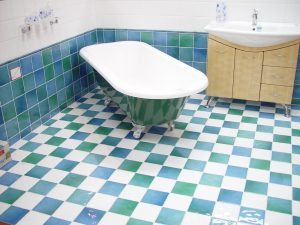
La vasca is a typical element of most home bathrooms in Italy. Do you have a vasca at your home, or a doccia? Or both?
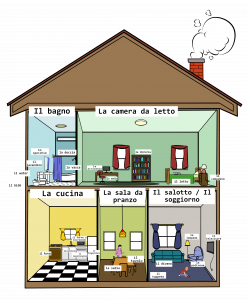
Nota culturale
What is a bidè? If you’ve been to an Italian home or hotel, you’ve likely encountered one. Let’s just say that is used for quick and efficient personal hygiene. This is an important Italian cultural lesson! 😉
Esercizi
A. Dove si trova? Scrivi ogni mobile accanto al nome della stanza in cui è tipicamente trovato.
| la poltrona | il bidè | il forno | il letto | il tavolo |
| il lavandino (lavabo) | il frigorifero | il comodino | la lavastoviglie | il divano |
| il bagno | 1.
2. |
| la camera da letto | 1.
2. |
| il salotto / il soggiorno | 1.
2. |
| la cucina | 1.
2. 3. |
| la sala da pranzo
|
1.
|
B. Dove si fa? Scegli la parola appropriata per completare la frase.
Es. Metto la macchina in (salotto / garage).
- Cristina prepara la cena in (bagno / cucina).
- Ci sediamo sul (balcone / divano) e guardiamo la tv in soggiorno.
- Uso il (lavandino / lavatrice) per lavarmi le mani.
- I ragazzi dormono sul (comodino / letto).
- Alex si mette sulla (lampada / poltrona) per riposarsi e guardare la tv.
- Prendete un po’ di aria sul (tappeto / balcone).
- Prendo i vestiti dall’(armadio / frigo) e mi vesto.
- In camera, hai molti libri sugli (schermi / scaffali).
C. Com’è casa tua? A coppie, fatevi le seguenti domande sulle vostre abitazioni mentre siete all’università. Scrivete le risposte dell’altra persona.
- Abiti sul campus, o fuori campus?
- Quanti compagni di casa hai?
- Hai una camera da letto singola, o condividi (do you share) la camera con un’altra persona?
- Cosa c’è nella tua camera da letto?
- Hai un bagno privato o un bagno in comune?
- C’è una cucina che puoi usare? Cosa c’è nella tua cucina?
D. Com’è la casa dei vostri sogni? Lavorando in gruppi di 2-3, “costruite” e descrivete la casa dei vostri sogni. Potete scrivere o disegnare la vostra descrizione. Considerate le seguenti domande mentre “costruite” la casa, e poi presentate il vostro disegno alla classe.
- Dov’è la casa?
- È un appartamento o una casa singola?
- Quante camere da letto ci sono?
- Quanti bagni ci sono?
- Quanti piani ha?
- Cosa ha di speciale o di unico?
Nota culturale
Italians number the floors of their buildings differently from how we number them in the US. Rather than entering a building on the “first floor”, you enter on the pianterreno or piano terra (ground floor). The next floor up is the primo piano (first floor) then secondo piano, terzo piano, quarto piano, and so on.
5.3 Le preposizioni
Look back at the house at the beginning of the previous section. We have now defined and identified the different rooms and objects commonly found in a house. Now we can discuss where those things are in relation to one another. Look at the following example:
Mi faccio la doccia in bagno. 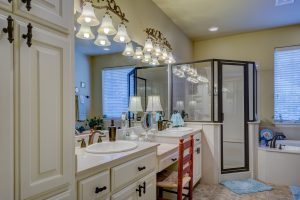
In this example, “in” is a preposition (preposizione) that indicates location. Prepositions (preposizioni) in general are these tiny little words that can indicate location, as in the example above, as well as direction, time, or to introduce an object. They can be followed by a noun (like bagno), a phrase with a noun (like il bagno), a pronoun (like me*) or a verb in the infinitive (like lavare).
There are simple prepositions, combined prepositions, and prepositions of place, and we’re going to cover them all in this section of the chapter. You’ve already seen and used a lot of them without even realizing it!
Study tips
*When a pronoun follows a preposition, as in the example, it uses what is called a “tonic” form (not to be confused with the direct and indirect object forms that you will learn about in Italian 120). These forms are easy to remember, because they are mostly similar to the subject pronouns you learned in Capitolo 1: per lui, per lei, per noi, per voi, per loro. The only differences are in the first and second person singular: per me, and per te.
Sometimes prepositions in Italian will function just as they do in English and sometimes they’ll be pretty different. Don’t be discouraged! They’re just tiny little words, and getting them right all the time takes practice.
Here are some examples from the house in the previous section. Can you circle or underline the prepositions? Can you tell which ones are simple and which are combined? And what are they combined with?
Ecco l’appartamento di Alex. Abita al secondo piano di un condominio nel sestiere* di Cannaregio a Venezia con due compagni dell’università. Nel suo appartamento ci sono tre camere da letto e due bagni. La sua camera da letto è accanto al bagno e a destra della cucina. Nella camera da letto c’è un letto matrimoniale nell’angolo e un comodino a sinistra del letto. Sul comodino c’è una lampada e una sveglia. Su una parete ci sono delle foto della sua famiglia, e su un’altra ci sono dei poster dei suoi gruppi musicali preferiti. Ha anche una piccola scrivania per studiare.
*Nota culturale
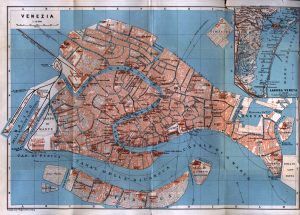 One of the many unique things about the city of Venice, in comparison with other major Italian cities, are the distinct names for the neighborhoods, squares and streets of the town. Sestiere is the name for a district, or neighborhood, of the city. The name itself indicates that there are six sestieri in total. Cannaregio is to the north, near the Santa Lucia train station and where the historic Jewish ghetto is located. Other unique terms include campo, which is used in place of piazza for square (with the exception of Piazza San Marco, the biggest square in the city). Instead of via or strada, we find calle, and if these streets run along the canals of the city, they are called fondamenta. These are just a few examples–the toponymy of Venice is truly unique. And look at the map–can you see that from above, Venice is shaped like a fish?
One of the many unique things about the city of Venice, in comparison with other major Italian cities, are the distinct names for the neighborhoods, squares and streets of the town. Sestiere is the name for a district, or neighborhood, of the city. The name itself indicates that there are six sestieri in total. Cannaregio is to the north, near the Santa Lucia train station and where the historic Jewish ghetto is located. Other unique terms include campo, which is used in place of piazza for square (with the exception of Piazza San Marco, the biggest square in the city). Instead of via or strada, we find calle, and if these streets run along the canals of the city, they are called fondamenta. These are just a few examples–the toponymy of Venice is truly unique. And look at the map–can you see that from above, Venice is shaped like a fish?
Let’s start with simple prepositions. Again, you’ve already seen and used most of these!
Preposizioni semplici
Quali sono?
| in | a | su | di | da | per | con |
| in, at, to* | in, at, to* | on, on top of | of, about | from, by | in order to, for | with |
Come e quando si usano?
| Preparo la cena in cucina.
Studio in biblioteca. Andiamo a Venezia in treno. |
-rooms of the house (bagno, cucina, salotto, camera da letto)
-certain common, non-specified places (biblioteca, banca, piscina, montagna, centro, campagna, città)* |
| Abita a Venezia.
Va a scuola. Andiamo in centro a piedi. |
-cities
-certain common, non-specified places (casa, scuola)* -certain modes of transport (a piedi) |
| Ci sono foto su una parete. | |
| Ecco l’appartamento di Alex.
Parla di filosofia. |
-possession (’s)
|
| Vengo da Venezia.
Vado da Michele. |
-provenance
-before a name or profession to indicate ‘s (Michele’s house, doctor’s office) |
| Ha una scrivania per studiare.
Ho una sorpresa per te. |
-before the infinitive form of the verb
-before a noun or pronoun |
| Abita con due compagni dell’università. |
*Study tip
You surely noticed that both a and in can mean in, at, or to…so how do you know which one to use? The table above provides some helpful categories to consider (for example, a with cities, like a Roma and in with states or countries, like in Italia). Some common places in the community or around the house just need to be memorized. Here are some examples to start practicing:
| a casa | in città |
| a scuola | in centro |
| a letto | in piazza |
| a teatro | in piscina |
| a piedi | in montagna |
| in bagno | |
| in cucina | |
| in salotto | |
| in camera da letto |
Esercizi
A. Preposizioni semplici. Scegli la preposizione appropriata per ogni frase.
Es. Preparo la cena (a / in ) cucina.
- L’appartamento è (di / da) Alex.
- Mi siedo sul divano (per / su) guardare la televisione.
- Parlo (in / con) i miei compagni di casa.
- Preferisco studiare (in / a) biblioteca.
- Stasera io e i miei amici rimaniamo (con / a) casa.
- Il treno parte (da / su) Venezia alle 8 di mattina.
Now look at that last example. Alle 8. You should remember this from Capitolo 3 about telling time. In this case, alle is made up of two parts: the preposition a and the definite article le (for le ore). In Italian, when a preposition and a definite article are next to each other in a sentence, they almost always combine. Sometimes they require a few alterations in spelling, too. Look at the table below and see if you can identify the patterns, the spelling changes, and the ones that don’t combine.
Preposizioni articolate
| il | lo | l’ | la | i | gli | le | |
| in | nel | nello | nell’ | nella | nei | negli | nelle |
| a | al | allo | all’ | alla | ai | agli | alle |
| su | sul | sullo | sull’ | sulla | sui | sugli | sulle |
| di | del | dello | dell’ | della | dei | degli | delle |
| da | dal | dallo | dall’ | dalla | dai | dagli | dalle |
| per | per il | per lo | per l’ | per la | per i | per gli | per le |
| con | con il | con lo | con l’ | con la | con i | con gli | con le |
Finish the following rules based on the table above:
- in changes to ________________________
- di changes to ________________________
- an extra “l” is added to combinations with the definite articles ________________________, ________________________, ________________________, ________________________.
- when a preposition combines with the definite article il, the letter ________________________ is eliminated.
- the prepositions ________________________ and ________________________ do not combine with the definite article.
Study tip
In Capitolo 4 you learned that, when referring to singular family members, it is not always necessary to use the definite article (like mio fratello or nostra cugina) if these words are not modified with something else. The same is true of common places in the home or town. If you are not referring to the proper name, or to a specific example, of these common places, you can use the simple preposition. For example, Studio in biblioteca. If you add more descriptive information, though, you would use the combined preposition form: Studio nella biblioteca pubblica. An example for the home is Vado in bagno, or Vado nel bagno al secondo piano. Some common places, however, like supermercato or ristorante, always use the combined form (Vado al supermercato. Mangio al ristorante). You will become more comfortable with these small distinctions as your Italian progresses.
Esercizi
B. Cosa c’è nella tua casa? Scrivi la preposizione articolata per completare la frase. La preposizione è tra parentesi, ma è necessario identificare l’articolo determinativo della parola successiva per arrivare alla forma corretta.
Es. (In) __________ appartamento ci sono tre camere da letto. → Nell’appartamento ci sono tre camere da letto.
- Questa è la camera da letto (di) ________________________ compagno di casa di Alex.
- Lui ha un letto matrimoniale (in) ________________________ angolo della camera.
- Accanto (a) ________________________ letto c’è un comodino.
- Ha una lampada (su) ________________________ comodino.
- Ha anche una libreria (per) ________________________ suoi libri*.
- Lui studia (da) ________________________ mattina (a) ________________________ sera–è molto studioso!
C. Semplice o combinata? A o in? Completa il paragrafo con le seguenti preposizioni, semplici o articolate a seconda del contesto.
| in | nel | nella | a | al | alle |
Alex va sempre all’università ________________________ piedi. Frequenta le lezioni dalle 9 ________________________ 4. Dopo, studia ________________________ biblioteca dell’università fino alle 6. Si ferma ________________________ supermercato per prendere qualcosa per cena. Quando arriva a casa va subito ________________________ cucina per mettere le cose in frigo. Va ________________________ bagno accanto alla cucina per lavarsi e rinfrescarsi (to freshen up) un po’, e poi torna in cucina per preparare la cena.
*Study tip
When a possessive is involved, the form of the combined preposition might change. For example, Nell’appartamento ci sono tre camere da letto uses the nell’ form because the word that immediately follows it (appartamento) begins with a vowel. If we put a possessive in that same sentence (Nel mio appartamento ci sono tre camere da letto) we use the nel form because the word that immediately follows it now starts with a consonant.
Did you think your study of prepositions was over? There’s just one more type to cover for now: prepositions of place (preposizioni di luogo), and they combine a lot of what you have already learned. In the previous exercise, there’s an example: accanto alla cucina. Accanto a is an example of a preposition indicating place. Notice that the final -a also combines with the definite article of the word that follows it. Here are some other common examples:
Preposizioni di luogo
| accanto a | next to |
| vicino a | near |
| lontano da | far (from) |
| davanti a | in front of, ahead of, before |
| di fronte a | in front of, facing |
| a destra di / a sinistra di | to the right of / to the left of |
| dietro | behind |
| sopra | above |
| sotto | below |
| tra/fra | between |
| all’angolo (di) | in the corner (of) |
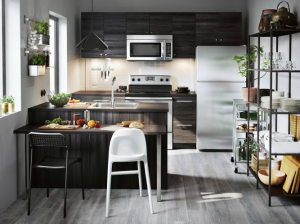
Il forno è sotto il forno a microonde.
Il forno è vicino al frigo.
Il forno è tra il frigo e la finestra.
Altri esempi?
Esercizi
D. Dove ci sono le cose? Indica se le seguenti frasi sono vere o false secondo le immagini. Se le frasi sono false, correggile!
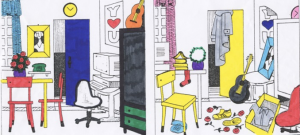
| 1.Nell’immagine a destra, c’è un telefono sotto la sedia gialla. | Vero | Falso |
| 2. Nell’immagine a destra, c’è una chitarra vicino alla finestra. | Vero | Falso |
| 3. Nell’immagine a destra, c’è un quadro accanto all’armadio. | Vero | Falso |
| 4. Nell’immagine a destra, ci sono delle scarpe nell’angolo. | Vero | Falso |
| 5. Nell’immagine a destra, c’è una buccia di banana (banana peel) sopra i libri. | Vero | Falso |
| 6. Nell’immagine a sinistra, ci sono dei fiori sul tavolo. | Vero | Falso |
| 7. Nell’immagine a sinistra, c’è un orologio sotto la porta. | Vero | Falso |
| 8. Nell’immagine a sinistra, c’è una sedia davanti al computer (antichissimo). | Vero | Falso |
| 9. Nell’immagine a sinistra, c’è un armadio a destra della scrivania. | Vero | Falso |
| 10. Nell’immagine a sinistra, c’è un poster sopra il computer. | Vero | Falso |
E. Cosa c’è nell’aula? Parte I. In gruppi di 2-3, descrivete gli elementi dell’aula usando diverse preposizioni di luogo. Scrivete almeno 5 esempi.
Es. C’è una lavagna davanti alla classe.
Parte II. Sapete che ci sono 5 caramelle/cioccolatini nell’aula? Dove sono? Formulate delle domande come la seguente per trovarle/li!
Es. C’è un cioccolatino sotto la sedia?
F. Parte I. Che cosa c’è nella camera da letto di uno studente? A coppie, scrivete una lista degli oggetti più tipici che si trovano nella camera da letto di uno studente/una studentessa universitario/a. Ricordatevi di includere gli articoli determinativi e indeterminativi! Se ci sono delle parole che non conoscete, basta chiedere all’insegnante!
Es. C’è/ Ci sono…
Parte II. Disegniamo! Descrivi la tua camera da letto al tuo compagno/alla tua compagna. Indica cosa c’è, e la posizione degli oggetti e dei mobili. L’altra persona deve disegnare la camera secondo le tue indicazioni.
Es. Nella mia camera da letto, c’è un letto nell’angolo a destra…
5.4 I verbi riflessivi
Now that you are familiar with Alex’s home, let’s look at his typical daily routine!
 |
 |
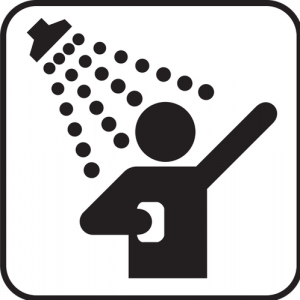 |
| Si sveglia alle 7. | Si alza. | Si fa la doccia. |
 |
 |
 |
| Si veste. Si mette i jeans e una maglia. | Fa colazione. | Si lava i denti. |
What form are the verbs above? What do almost all of the sentences have in common?
Can you match the conjugated forms with their infinitive forms? What do you notice about the infinitives?
| Si fa | svegliarsi |
| Si lava | mettersi |
| Si sveglia | farsi |
| Si alza | vestirsi |
| Si veste | lavarsi |
| Si mette | alzarsi |
You might notice two things by comparing the conjugated forms with the infinitive forms: 1. the “si”; and 2. that the verbs still end in –ar, -er, and -ir, and that the second part of the conjugation looks pretty normal. If you encounter a verb that ends in -arsi, ersi, or -irsi, it is a reflexive (riflessivo) or reciprocal (reciproco) verb, and it requires an extra pair of letters to complete its conjugation.
A reflexive verb is an action that one does to oneself. You learned an important reflexive verb in Capitolo 1! Mi chiamo Alex is a reflexive form that means “I call myself Alex.” Notice that for the “io” form of the verb, the reflexive pronoun or pronome riflessivo (the name for those two letters that precede the rest of the conjugated verb) is mi, while for the “lui/lei” form (as we see above) is si.
To conjugate reflexive verbs, you still remove the -arsi, ersi, and -irsi endings, just like you do with regular present tense verbs. Once you have the root of the verb, you add the same endings you learned about in Capitolo 3. Then, you add the reflexive pronoun that corresponds to the subject before the verb. Or, you can do that process in reverse! Whatever works for you! Part of learning a language is coming up with strategies and approaches that click with you the most!
Look at this conjugation chart. We have already seen examples with “io” and “lui/lei”. What do we need to add to the “tu”, “noi”, “voi” and “loro” forms? Which two forms have the same reflexive pronoun?
| alzarsi (to get up) |
mettersi (to put on) |
divertirsi (to have fun) |
|
| io | mi alzo | mi metto | mi diverto |
| tu | ti alzi | ti metti | ti diverti |
| lui/lei/Lei | si alza | si mette | si diverte |
| noi | ci alziamo | ci mettiamo | ci divertiamo |
| voi | vi alzate | vi mettete | vi divertite |
| loro | si alzano | si mettono | si divertono |
Study tip
When a verb ends in -si, then you know you need to conjugate it like the verbs above, Es. Ci alziamo alle 8. However, all of these verbs can also exist in a non-reflexive form, like alzare, mettere, divertire. When there is no -si at the end, these verbs are conjugated normally, Es. Alziamo il volume.
Here are some other typical reflexive verbs:
| annoiarsi | to get bored |
| riposarsi | to rest |
| laurearsi | to graduate |
| arrabbiarsi | to get angry |
| sposarsi | to get married |
| innamorarsi | to fall in love |
| sentirsi | to feel |
| pettinarsi | to comb one’s hair |
| truccarsi | to put on make up |
| farsi la barba / depilarsi | to shave one’s beard / to shave one’s legs |
| asciugarsi | to dry off |
| rilassarsi | to relax |
Esercizi
A. Come ti chiami? Scegli i pronomi riflessivi appropriati per completare le frasi seguenti.
Es. Io ________ chiamo Alex.
| a. mi | b. si | ci. ci |
- La mia migliore amica _____ chiama Eleonora.
a. vi b. ci c. si - Io e Eleonora _____ divertiamo molto insieme.
a. ci b. mi c. ti - Io _____ sveglio presto la mattina.
a. ti b. mi c. vi - Eleonora e Alex _____ lavano i denti prima di uscire di casa.
a. ci b. vi c. si - Tu e Alex _____ mettete le lenti a contatto (contact lenses)?
a. vi b. ti c. mi - A che ora _____ alzi, tu?
a. mi b. ti c. si
B. Ci divertiamo! Coniuga i verbi tra parentesi secondo le indicazioni date.
Es. Io ____mi chiamo_______(chiamarsi) Alex.
- Eleonora ____________________________________________________________ (arrabbiarsi) quando c’è molto traffico.
- Tu e Eleonora ____________________________________________________________ (addormentarsi) sempre tardi, dopo mezzanotte!
- Io ____________________________________________________________ (laurearsi) all’università a maggio. Non vedo l’ora di finire!
- I miei amici ____________________________________________________________ (sposarsi) in estate. Sono proprio innamorati!
- A che ora ____________________________________________________________ (svegliarsi) tipicamente, tu? Presto o tardi?
- Durante il fine settimana, io e i miei amici ____________________________________________________________ (divertirsi) nei locali della città.
- Federico e Eleonora, come ____________________________________________________________ (vestirsi) per la festa? Che cosa ____________________________________________________________ (mettersi)?
- Che lezione lunga! Oggi gli studenti ____________________________________________________________ (annoiarsi) tanto.
C. Riflessivo o no? Decidi se le seguenti azioni sono riflessive o no. Scegli il verbo corretto.
Es. Io (mi chiamo / chiamo) mio fratello al telefono.
- Eleonora (si mette / mette) la giacca prima di uscire di casa.
- Eleonora (si mette / mette) il latte in frigo.
- Eleonora e Alex (si lavano / lavano) i piatti dopo cena.
- Eleonora e Alex (si lavano / lavano) i denti prima di andare a dormire.
- Come (ti senti / senti) oggi? Stai ancora male?
- (Ti senti / senti) questa musica? È bellissima!
- (Vi svegliate / svegliate) presto la mattina.
- (Vi svegliate / svegliate) i vostri compagni di casa alle 7?
D. Ti diverti durante le lezioni d’italiano? Parte I. In gruppi di 3, fatevi le seguenti domande. Scrivete brevemente le risposte de* vostr* compagn*.
| Compagn* 1 | Compagn* 2 | |
| A che ora ti svegli durante la settimana?
|
||
| Ti diverti durante le lezioni d’italiano?
|
||
| Ti annoi spesso? Se sì, quando?
|
||
| Quando ti laurei?
|
||
| Cosa fai per rilassarti?
|
||
| In quali situazioni ti arrabbi?
|
Parte II. Ora che hai le risposte di tutt*, puoi formulare frasi diverse per descrivere le vostre abitudini. Avete cose in comune? Siete molto diversi? Scrivete almeno 5 frasi (con soggetti diversi) per descrivere le vostre routine. Seguite i seguenti esempi.
Es. Io mi sveglio alle 8, ma Eleonora e Alex si svegliano alle 9.
Io e Eleonora ci laureiamo a maggio, ma Alex si laurea il prossimo anno.
1.
2.
3.
4.
5.
Parte III. RIPASSO! Vi ricordate i superlativi che avete studiato (you studied) nel Capitolo 4? In base alle risposte alle domande di sopra, formulate diversi superlativi per descrivere i membri del vostro gruppo. Poi, condividete i vostri superlativi con il resto della classe!
Es. Io sono il meno attivo del gruppo. Alex è il più tranquillo del gruppo. È tranquillissimo!
5.5 Gli avverbi
Over the last few chapters, you have learned how to talk about your typical activities, hobbies, and routine. Now let’s see if we can add even more description to these actions. One way to do that is by adding an adverb (avverbio). Just like an adjective (aggettivo) describes a person, place or thing (Es. La giraffa è alta), an adverb describes (wait for it….) a verb! But not only! It can also modify an adjective or another adverb. Adverbs can express when, where, how and how often something occurs. Just like in English, there are some forms that follow a pattern, some that are irregular, and some that you just have to learn.
What do the italicized words communicate in the following examples? Match each sentence with the question addressed by the adverb.
| Alex si sveglia presto. | quanto spesso? |
| Alex si sveglia qui alle 5. | come? |
| Alex si sveglia lentamente. | dove? |
| Alex si sveglia spesso alle 7. | quando? |
Adverbs of manner answer the questions how or how often?
Alex studia sempre.
Alex studia bene in biblioteca ma a casa studia male.
Alex studia regolarmente in biblioteca.
Alex studia raramente a casa.
Note that these last two examples end with the suffix -mente. This corresponds to the -ly form in English. Let’s take a look at how we form them in Italian.
In most cases, we add -mente to the feminine, singular form of an adjective. Here are some examples:
raro → rara → raramente
allegro → allegra → allegramente
lento → lenta → lentamente
Now you try! generoso → ____________________________________________________ → ____________________________________________________
However, if the feminine, singular form of the adjective ends in -e, we don’t make any spelling changes and just attach -mente on the end. Like this:
elegante → elegantemente
Now you try! triste → ____________________________________________________
There are two exceptions to this last rule, however. If the feminine, singular form of the adjective ends in -le or -re, then we drop the final -e before adding -mente. If you try to pronounce these with that final -e, then you understand why it gets omitted! For example:
difficile → difficil → difficilmente
regolare → regolar → regolarmente
Now you try!
puntuale → ____________________________________________________ → ____________________________________________________
particolare → ____________________________________________________ → ____________________________________________________
Other adverbs that express how and how often have their own forms. One common example (and one that tends to confuse students a great deal!) is bene and its opposite, male: Es. Alex canta bene ma balla male. Bene/male are adverbs, while buono/cattivo are adjectives. This means that we can say that pasta is good (la pasta è buona) and that Alex cooks the pasta well (Alex cucina bene la pasta).
Other common adverbs that express time, quantity, and place are:
ieri / oggi / domani
presto / tardi
in anticipo / in orario / in ritardo
molto / poco / tanto / troppo
mai / spesso / sempre
qui / qua / lì / là
Study tip
Sometimes it is useful to study words in groups according to their meaning. The words above, for example, are all related to one another and therefore learning them together can help you to remember them better.
Esercizi
A. Sinceramente parlando. Cambia l’aggettivo tra parentesi in un avverbio per completare le seguenti frasi.
Es. Alex offre ___generosamente_____________(generoso) il caffè agli amici.
- Alex parla ____________________________________________________ (onesto) con i suoi amici.
- Federico si veste ____________________________________________________ (elegante) per i suoi appuntamenti romantici.
- Caterina guida la macchina ____________________________________________________ (veloce).
- Alex e Federico convivono (live together) ____________________________________________________ (felice).
- Tu sei ____________________________________________________ (particolare) brava a disegnare!
- Quando volete qualcosa nel negozio, dovete chiedere ____________________________________________________ (gentile) al commesso/alla commessa.
- Questo appartamento è ____________________________________________________ (terribile) rumoroso!
- Sono ____________________________________________________ (estremo) stanca oggi!
B. Due approcci diversi. Alex e Federico fanno le cose diversamente. Completa il paragrafo con gli avverbi seguenti per identificare queste differenze.
| puntualmente | mai | tardi | frequentemente | lentamente | molto |
Alex e il suo compagno di casa Federico sono molto diversi. Alex si sveglia sempre presto, alle 7, ma Federico si sveglia ____________________________________________________, verso le 11. Alex si prepara per la sua giornata velocemente, invece Federico si prepara ____________________________________________________. Mentre Federico arriva in ritardo a quasi tutti i suoi appuntamenti, Alex arriva sempre ____________________________________________________. Federico studia poco, ma Alex studia ____________________________________________________. Federico, però, lavora molto per il bene della comunità e partecipa sempre a manifestazioni contro le ingiustizie. Alex, invece, non partecipa ____________________________________________________ a eventi di questo genere. Alex lascia raramente la biblioteca durante la giornata, mentre Federico si trova ____________________________________________________ in piazza a lottare per un mondo migliore.
C. Completa le frasi! A coppie, completa le frasi in maniera logica, secondo le vostre esperienze. Provate a variare gli avverbi che usate! Che cosa avete in comune e come siete divers*?
- Io guido la macchina ____________________________________________________.
- Io cucino ____________________________________________________.
- Io arrivo a lezione ____________________________________________________.
- Io canto ____________________________________________________.
- Io ballo ____________________________________________________.
- Io gioco a tennis/golf/calcio/pallavolo/pallacanestro ____________________________________________________.
- Io disegno ____________________________________________________.
- Io studio ____________________________________________________.
- Io suono il pianoforte/la chitarra/la batteria ____________________________________________________.
- Io scrivo ____________________________________________________.
D. Bingo! Parlando con tutta la classe, cerca persone che fanno le seguenti attività. Formula le domande nella forma “tu” e scrivi il nome della persona che corrisponde ad ogni frase. 5 caselle orizzontali, verticali o diagonali vincono! Cosa significa “Jolly”?
| suonare bene uno strumento musicale | guardare raramente la tv | fare regolarmente i compiti d’italiano | arrivare a lezione puntualmente | parlare onestamente con i genitori |
| non pulire mai la sua camera da letto | svegliarsi presto la mattina | guidare velocemente | cantare male | leggere molto |
| dormire poco | ballare bene |
JOLLY |
andare spesso da Starbucks | prendere sempre buoni voti |
| non studiare mai in biblioteca | addormentarsi tardi | laurearsi presto | andare frequentemente al cinema | mangiare poco la mattina |
| giocare spesso ai videogiochi | ascoltare sempre i professori/le professoresse | avere tre lezioni oggi | vestirsi elegantemente per un’occasione speciale | non annoiarsi mai durante la lezione d’italiano |
5.6 Guardiamo!
Fantozzi (Salce 1971)
Nota culturale
The following blog post provides a comprehensive overview of the character of “ragioniere Ugo Fantozzi” and the perspective this representation provides not only on the Italian culture of the time his films were released, but also today. https://www.michelelancione.eu/blog/2017/07/03/the-best-intro-i-ever-received-on-class-struggle-il-primo-tragico-fantozzi/. He provides an often humorous depiction of class struggle and insight into Italian industry and economic structures. Because of this, his name has even entered into the lexicon of popular culture: “una giornata da Fantozzi” indicates a day in which everything seems to go wrong. His name is even an adjective: “fantozziano/a” refers to something or someone that is awkward or unlucky.
Esercizi
A. A che ora si sveglia Fantozzi? Guarda il video fino al 1:17 e metti in ordine le prime 10 cose che fa Fantozzi la mattina.
- Beve il primo caffè mentre è sulla cyclette. __________
- Entra in cucina e dà un bacino a sua figlia. __________
- Si sveglia alle 7.51. ___1_______
- Si mette a fare attività fisica sulla cyclette. __________
- Si fa la barba velocemente. __________
- Guarda sua moglie. __________
- Corre in bagno perché il caffè è troppo caldo. __________
- Si alza. __________
- Beve l’acqua direttamente dal rubinetto del lavandino in bagno. __________
- Si lava e si asciuga rapidamente. __________
B. E poi, cosa fa? Ora guarda il resto del video. Indica con un ✅ tutte le attività che fa.
| Si pettina mentre fa colazione. | ✅ |
| Si lava i denti in bagno. | |
| Si veste con l’aiuto di sua moglie. | |
| Esce dalla porta di casa per andare al lavoro. | |
| Sale sull’autobus senza problemi. | |
| Gli altri passeggeri dell’autobus si arrabbiano con lui. | |
| Arriva al lavoro in ambulanza. | |
| Cammina con calma a timbrare il cartellino. | |
| Timbra il cartellino (he clocks in) alle 8.30. |
C. Raccontiamo! Parte I. Mettendo insieme le risposte dei due esercizi di sopra, potete raccontare gli eventi di questa scena? Lavorate a coppie e praticate la vostra recita ad alta voce. Usate le seguenti parole per organizzare il vostro racconto.
Prima….
Poi…
Dopo…
Alla fine…
Parte II. E dopo? Immaginate quello che succede dopo che Fantozzi timbra il cartellino. Come va la sua giornata di lavoro? Cosa fa e come sono queste attività? Scrivete la scena e ricordatevi che Fantozzi è un personaggio estremamente sfortunato (e comico)!
5.7 Punto culturale: il turismo italiano dopo Covid
A. Il turismo in Italia prima e dopo il Covid-19. Leggi l’articolo e rispondi alle domande.
Venice Glimpses a Future with Fewer Tourists, and Likes What It Sees
- What were Venetians protesting at the beginning of the article? Why is it a problem?
- What are some of the negative impacts of tourism on the Italian peninsula?
- What are some positive impacts of the lack of tourism due to Covid-19 on Venetian life specifically?
- What are some proposed suggestions for making Venice less reliant on tourism and more sustainable for local residents?
- How does Prof. Ferlenga envision a “new” Venice? Specifically, what is the role that universities would play?
- What are two opposing arguments for the role of Airbnb in Venice?
B. Che ne pensi? Discuti le seguenti domande con un/a partner.
- What do you think of some of the proposed solutions to help Venice become a more livable city for its residents?
- Does your hometown or city welcome many tourists each year? What are the positive and negative impacts of this, in your view?
- Have there been any effects of Covid-19 that have ultimately proven to be positives in your life?
C. La vita studentesca a Venezia. Com’è essere uno studente universitario a Venezia? A coppie, fate una ricerca sulle diverse università della città. Dov’è la sede principale? Quali facoltà ci sono? Quanto costa studiare lì all’anno? Dove si può vivere? Quale università preferisci e perché?
| Area della città | Facoltà | Costo | Quale preferisci e perché? | |
| Università Ca’ Foscari |
|
|||
| Università IUAV di Venezia |
|
|||
| Venice International University |
|
Ripasso del capitolo
At the end of this chapter, you should be able to:
- talk about your daily routine
- describe your home environment
- refer to the positions and places of people, animals and/or objects
- describe the manner, time, and frequency of your typical activities and those of others
- conjugate present tense reflexive verbs
- understand the difference between simple and combined prepositions
- formulate combined prepositions
- formulate adverbs in the -mente form
- talk about the effects of Covid-19 and tourism on the city of Venice
- describe the routine, behavior, and home environs of another person
Prove it!
Il vocabolario
| italiano | English |
| La casa
*Le stanze e gli spazi il pianterreno / il piano terra
*I mobili il condizionatore / il climatizzatore
Le preposizioni semplici
Le preposizioni di luogo
I verbi riflessivi |
The house
*Rooms and spaces balcony bathroom bedroom basement / cellar yard kitchen garage garden vegetable garden floor ground floor front door / main door dining room living room stairs
*Furniture dresser / closet clothes dryer bidet nightstand air conditioner couch / sofa shower oven microwave oven stovetop / cooktop (burners) refrigerator wardrobe / closet lamp bathroom sink sink (bathroom or kitchen) dishwasher washing machine bed bookcase armchair bookshelf desk chair mirror rug dining table television set heater bathtub toilet
Simple prepositions to, at, in with from of, about to, at, in for on between
Prepositions of place to the right of / to the left of next to in front of, before in front of, facing behind far (from) in the corner above below near (to)
Reflexive verbs to fall asleep to get up to get bored to get angry to dry oneself off to call oneself, to be called/named to have fun to fall in love to shave one’s beard to graduate to wash oneself (to teeth, hands, etc…) to put on to comb one’s hair to rest to feel to get married to wake up to put on makeup to get dressed |
Answers to Inductive Activities
5.3 1. ne 2. de 3. il, la, l’, le 4. i 5 con and per
5.5 generosamente, tristemente, puntualmente, particolarmente

